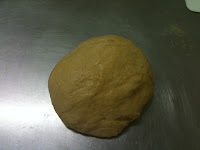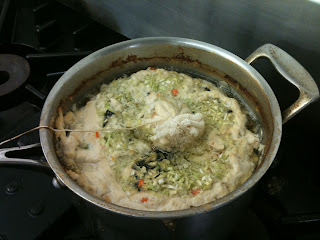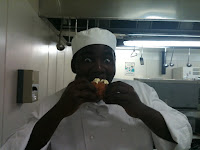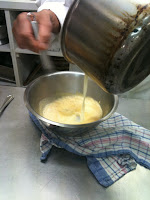You will recall my despair in week 16: Sure to rise when I bemoaned my lack of bread making skills, but went on to bake successful products in class. This week is the same - I think it is safe to say yeast and I have formed an alliance. At least we have in the Weltec kitchen: whether it translates to home is another matter.
Monday we start with wholemeal bread rolls and bagels, and it's all a slippery butter slick from there.
Not much else gets the Heart Foundation tick this week. We spend a good part of the lesson also making the paste for croissants and Danish pastries, and doing the folding work which makes the layers - lamination in the culinary world - of pastry. If you have ever wondered just how much butter goes into these products I am now in a position to tell you. Heaps. By weight, the recipe for croissants has 450 grams of flour to 225 grams of butter. Danish pastries? Don't ask. OK then, I'll tell you. 225 grams of flour and 200 grams of butter. You may as well slap it directly onto your hips!
 |
| Layer of butter on croissant pastry |
In both cases the slab of butter is laid onto the rolled out dough (see picture), and then folded in and rolled again. Fold and roll three times, giving a half turn of the dough block each time. This means you are distributing the fat and adding layers. You can see the process on any number of you tube videos if you want to know the details. When the dough cooks, the fat melts and creates steam which puffs up the dough. The dough then cooks in place and the gap that is the flaky layer is created. Again, cooking as magic!
 The pastries for the croissants and danishes we let prove in the fridge overnight and roll out and bake the next day. I really enjoy shaping and making them all and they turn out well. When I show them to some of you the comment is unfailingly "they look like bought ones form the shop!" I'm not sure if I should be pleased with the comment or affronted by the surprise in your voice! Of course they are just like bought ones - only they taste better! The hunter gatherer is well pleased this week. Having missed out on the doughnuts (week 16: Sure to rise) he is happy when the cabin crew in from Dubai (son and girlfriend) pause in Wellington and can deliver fresh pastries to Marlborough.
The pastries for the croissants and danishes we let prove in the fridge overnight and roll out and bake the next day. I really enjoy shaping and making them all and they turn out well. When I show them to some of you the comment is unfailingly "they look like bought ones form the shop!" I'm not sure if I should be pleased with the comment or affronted by the surprise in your voice! Of course they are just like bought ones - only they taste better! The hunter gatherer is well pleased this week. Having missed out on the doughnuts (week 16: Sure to rise) he is happy when the cabin crew in from Dubai (son and girlfriend) pause in Wellington and can deliver fresh pastries to Marlborough. Dough, dough and more dough. Chelsea buns, brioche loaves, cornbread, focaccia, a wholegrain loaf (Heart Foundation tick on that one) and sourdough. There is no solace for the gluten intolerant in this world.
Dough performs its own special magic. To wit, brioche.
You start with a relatively straightforward sweetened yeast dough, and then add LOTS of butter. The dough is soooo sticky you are severely tempted to add flour. But you mustn't! You just keep kneading with your fingertips (so as not to overheat the dough), knead, knead, knead and - nek minnit - (yes, I am in touch with popular culture) it comes together into this smooth,silky and glossy dough. Then shape, prove again and bake into a lovely buttery yummy thing, which, I make into a dessert for hunter gatherer and the aforementioned cabin crew. Make french toast with the brioche (fry in butter - why the hell not?) and serve with poached rhubarb and yoghurt.
knead, knead and - nek minnit - (yes, I am in touch with popular culture) it comes together into this smooth,silky and glossy dough. Then shape, prove again and bake into a lovely buttery yummy thing, which, I make into a dessert for hunter gatherer and the aforementioned cabin crew. Make french toast with the brioche (fry in butter - why the hell not?) and serve with poached rhubarb and yoghurt.
 knead, knead and - nek minnit - (yes, I am in touch with popular culture) it comes together into this smooth,silky and glossy dough. Then shape, prove again and bake into a lovely buttery yummy thing, which, I make into a dessert for hunter gatherer and the aforementioned cabin crew. Make french toast with the brioche (fry in butter - why the hell not?) and serve with poached rhubarb and yoghurt.
knead, knead and - nek minnit - (yes, I am in touch with popular culture) it comes together into this smooth,silky and glossy dough. Then shape, prove again and bake into a lovely buttery yummy thing, which, I make into a dessert for hunter gatherer and the aforementioned cabin crew. Make french toast with the brioche (fry in butter - why the hell not?) and serve with poached rhubarb and yoghurt. Assessment sees us make and present Wholemeal rolls - 3 different shapes, glazed Chelsea buns and a whole Brioche loaf (as opposed to individual rolls). I gain another Distinction proving I must have shrugged off my yeast product jinx!
And while we are on the subject of Distinction, I also receive my results from the Certificate exam I did in week 18. Yes, I passed with Distinction which, while they don't tell you your mark, I am informed that means over 90%. All in all, a good week to break up for the holidays.
Back at school the week commencing January 16th. So until then, compliments of the season to you and yours and I look forward to blogging in 2012.




































